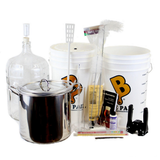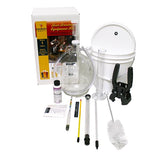Troubleshooting
712-B Merrimon Ave -- Asheville, NC 28804 -- 828-285-0515
Home brewing is easy, but things can happen that yield what we refer to as “special effects.” See if these sound familiar:
-
My beer is flat.
Did you prime it?
You have to add more nutrient at bottling time or the product won’t carbonate.
Is it conditioning at room temperature?
Bottling beer and sticking it in the fridge will yield flat beer, unless you’re working with lager yeast. We recommend a 65 degree environment whenever moving yeast. With the exception of lagers, we advise you to condition beer at room temperature for 10-14 days after bottling in order to ensure proper carbonation.
Did you cap securely?
Fugitive gas will yield flat, slightly oxidized beer. Invert all bottles on bottling day and listen for hissing, which would indicate a poor seal.
-
My beer is the opposite of flat – it foams like crazy.
Did you overprime?
Three-quarters of one cup of priming sugar is sufficient to prime 5 gallons of beer. Don’t overdo it.
Did you bottle too early?
If there was residual nutrient left in the fermenting batch when it was bottled, the math gets messed up. The beer will ferment the original nutrient and the newly introduced priming nutrient to produce too much carbon dioxide. We’ve found that chilling the beer thoroughly (say 20-25 minutes in a freezer) prior to serving lessens foaming.
Are you sure everything was clean?
Excessive foaming and awful flavors are also consistent with some kinds of wild yeast and/or bacterial infection. Review your sanitation method with us and be cautious when brewing outdoors, especially during the summer.
-
My beer is cloudy.
Is it a wheat beer?
It’ll probably be a tad cloudy.
Was grain present?
If grain is steeped above 170 degrees or boiled, protein infusion occurs, resulting in a beer that clouds noticeably when chilled. We recommend steeping adjunct grains at 155 to 160 degrees for 45 to 60 minutes and NEVER boiling grain.
What can I do?
You can use Irish Moss or Whirlfloc in the boil to help drop out proteins in the kettle. Once in the fermenter, you can use fining agents such as gelatin or SuperKleer. Several days of "cold crashing" will also help precipitate out proteins that cause chill haze. Pitching ClarityFerm at the same time you pitch your yeast will yield excellent clarity and precipitate out the bulk of the gluten.


